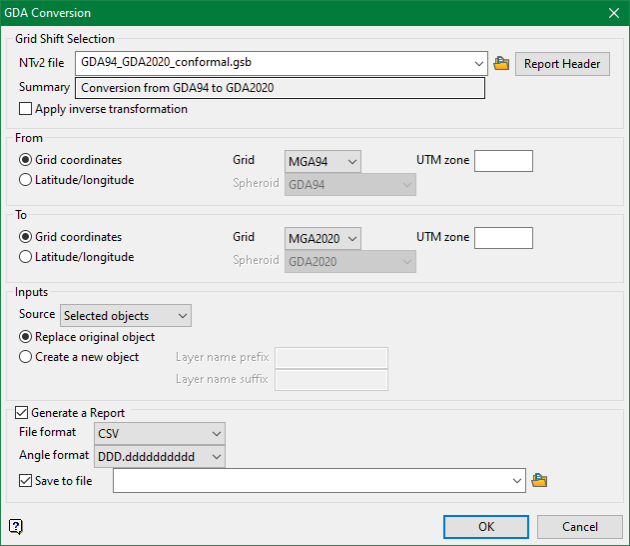GDA Conversion
Perform a Grid/Spheroid Conversion
Australia has used AMG and ISG coordinates, which are based on the Australian Geodetic Datum, however, to align with international spatial coordinate systems, Australia is switching to a system based on the Geodetic Datum of Australia. This coordinate system is called the Map Grid of Australia (MGA).
The GDA Conversion option to convert coordinates of selected objects from:
- Australian Map Grid (AMG) or Integrated Survey Grid (ISG) to Map Grid of Australia (MGA) and vice versa.
- Australian National Spheroid (ANS) to Geodetic Datum of Australia (GDA) and vice versa.
Useful websites are:
- Geoscience Australia
- Intergovernmental Committee on Surveying & Mapping GDA Technical Manual
You can convert data selected from the screen, or you can enter coordinates for conversion. You can also generate a report of the existing and transformed coordinates.
The grid file format supported is that supplied by mapping authorities. It is inNational Transformation V2 binary grid fileformat, and is actually a grid file of latitude/longitude shift values. It is possible to use one of the old Australian files, however, we recommend that you download a more current file from the ANZLIC website.
Instructions
- Select Design menu
- Select Transformation submenu
- Select GDA Conversion option
The following panel displays.

Grid Shift Selection
NTv2 file
Specify the NTv2 Grid file to use for the conversion. You can choose from the drop-down list if it's in the same directory or browse from a different location.
Report Header
This displays detailed information of the specified NTv2 file in the Report Window, such as number of sub grids, shift type, distortion model, semi-major/minor axes, sub grid name, parent, date of creation, latitude/longitude, and etcetera.

Summary
This provides a quick insight of the type of conversion being undertaken.
Apply inverse transformation
The NTv2 file contains a shift from one latitude/longitude system to another, normally from an older system to a newer system. Check this box to apply the reverse transformation to that defined in the file.
From/To
Grid coordinates
Select the Grid to be converted from/to and specify the respective UTM zones. Zones are entered as an integer for AMG (between 49-56) and as an integer plus a forward slash and the number 1, 2 or 3 for ISG (between 54/2 - 56/2).
Latitude/longitude
Select the Spheroid to be converted from/to. The conversion of spheroids can be from ANS to GDA or from an older version to a newer version, and vice-versa.
Inputs
Source
The input source can be either selected objects on the screen or entered coordinates. If the source is selected objects, you can:
Replace original object
The resultant object overwrites the original object.
OR,
Create a new object
The resultant object after conversion can be created as a new object. Enter the layer name prefix/suffix for the new object.
If you are performing a spheroid conversion (i.e ANS to GDA or the GDA to ANS options), then enter the Latitude and Longitude in either DDD.dddddddddd or DDD.MMSSssss format.

If you are performing a grid conversion, then enter the Easting and Northing.

Generate a Report
Select this check box to generate a report. For grid conversion, the report displays the current and transformed grid and geographic coordinates and for spheroid conversion, current and transformed geographic coordinates displays.
File format
Select the format in which the report is saved. It can be either a CSV file or columns.
Angle format
Select from the drop-down list to specify the format of the angle in the report.
Save to file
If you need to save the report in a separate file, enter the file name or select an existing file to overwrite.

